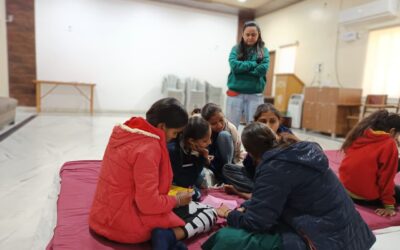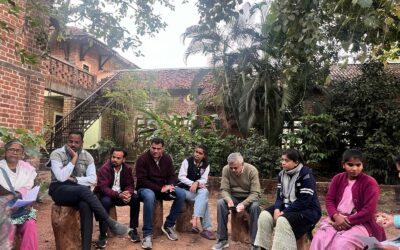I am currently researching the effects of biochar application on soil, with a related experiment taking place at RAMBLE (Research & Monitoring of the Banni Landscape), a research station located in the Banni Grasslands of Kutch, Gujarat.
This unique environment, characterised by its diverse flora and fauna, presents an intriguing backdrop for our study on biochar, a carbon-rich product derived from biomass pyrolysis.
The Promise Of Biochar
According to secondary literature, biochar offers various soil amendment benefits, such as improving nutrient retention, moisture-holding capacity, and pH regulation. These attributes make biochar an appealing option for enhancing soil fertility and agricultural productivity, particularly in areas facing land degradation and climate change impacts. Studies indicate that biochar can improve soil structure, increase microbial activity, and enhance the availability of nutrients—critical factors for sustaining healthy ecosystems.
Our experiment aims to assess the impact of biochar application specifically in the context of the grasslands. Initially, I had some doubts about using biochar alone, as literature suggests better results when mixed with compost.
However, to measure biochar’s individual effect, we decided to apply it directly, following the advice of the experiment lead. This decision reflects a commitment to understanding biochar’s standalone benefits, which could inform future soil management practices in similar landscapes.

Field Challenges And An Unexpected Hitchhike
I completed some tasks on my own, but others required assistance. Unfortunately, after waiting for some time, the field assistant never showed up, probably due to personal commitments. By 6PM, I found myself stuck in a remote area with no public transport or rickshaws available. With few options, I decided to hitchhike to Bhirandiyara, where public transport is more frequent.
After waiting for a bus that never arrived, I managed to get a ride in a government vehicle connected to one of the world’s largest solar farms. The driver warned that we might not have enough diesel to reach the next fuel station, but I took the risk since I had no better alternative.
The vehicle was supposed to refuel at specific stations since it was a government vehicle. However, we came to a halt 8km before reaching the fuel station. Fate seemed to be playing tricks on me that day. After several attempts to troubleshoot, we began asking for help from passers-by. Meanwhile, the driver contacted his seniors, and soon, a villager arrived with some fuel. Unfortunately, it didn’t resolve the issue, likely due to air blockage in the fuel line. Eventually, a car stopped to assist us, and we discovered it was the chairman of the local panchayat. He kindly offered to help, and I hitch-hiked with him.
He gave me the option to either go to a village where one of our organization’s drivers was located or to his home. Seizing the opportunity to connect with someone in a position of influence who could potentially support our landscape restoration project, I chose to go with him.
We made a stop at his friend’s farm for dinner, where a small gathering was taking place. I shared details about my work while enjoying a meal of rice, though I declined the drinks offered. Around midnight, we left for his home, where he kindly provided me a room for the night. Although I initially felt anxious about staying at a stranger’s home, I locked the door and managed to rest.
Reflecting On The Experience
The next morning, the chairman dropped me at the bus stand around 6AM. I finally felt relieved as I headed home. When I recounted the adventure to my colleagues, they expressed concern about the risks I had taken by staying at a stranger’s house. Since then, I’ve made sure to leave the Banni field area before dark to ensure safer travel.
Early Observations Of The Experiment
So far, we haven’t noticed a significant difference between the treatment plots and the control plots. While some biochar-treated plots show more grass growth, we suspect the elevation differences might be contributing to better water retention in those areas. However, these initial observations are just the beginning. As the experiment progresses, we anticipate gathering more data that could reveal subtle differences and trends. Our objective is to comprehensively understand the potential of biochar to enhance soil health in Kutch.
Over time, this research could lead to more refined application methods and optimised formulations that combine biochar with other amendments like compost. By examining the specific conditions of Kutch, we aim to tailor biochar applications to maximise their benefits in similar semi-arid regions around the world.
Moreover, this study underscores the importance of fieldwork and adaptability in research. Unexpected challenges like the ones I faced are part and parcel of working in remote areas, highlighting the need for resilience and resourcefulness.
These experiences not only contribute to personal growth but also enrich the overall research process, providing valuable insights that are often not captured in controlled lab environments. As we move forward, we are also exploring the socio-economic impacts of biochar application. Engaging with local communities and understanding their perspectives can provide a holistic view of biochar’s potential. The support from local stakeholders, like the chairman who assisted me, is crucial for the successful implementation and acceptance of biochar practices in the region.
While the journey has had its share of ups and downs, the promise of biochar as a sustainable soil amendment keeps us motivated. Our ongoing research at RAMBLE aims to contribute significantly to the body of knowledge on biochar, offering practical solutions for soil management in Kachchh and beyond.
Here’s to more discoveries, more adventures, and a greener future powered by biochar.





0 Comments